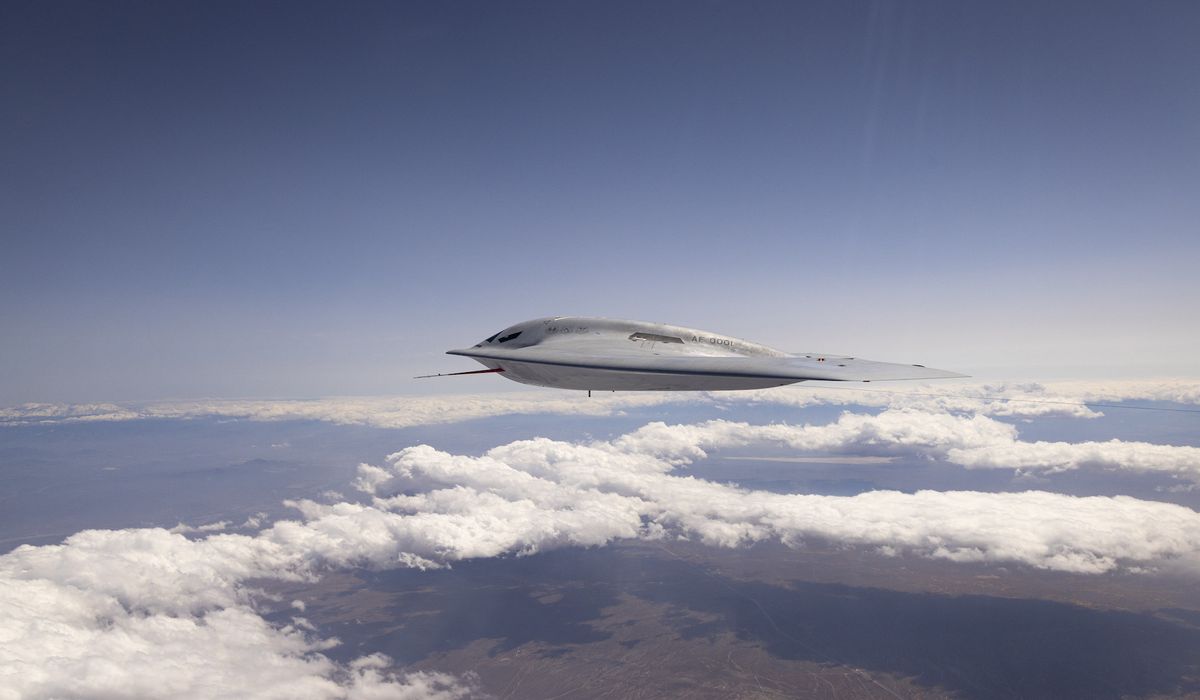


The Air Force this week made public the first photos of its new sixth-generation strategic bomber, the B-21 Raider, and military planners are divided over how best to use what will be one of America’s most powerful warplanes.
Two Air Force bomber experts are warning that the B-21’s full capabilities for use in non-nuclear military operations are not well understood and may be limited by bureaucratic tensions within the service.
“Combat air forces tacticians and operational planners have yet to understand the B-21 Raider’s potential capability,” the analysts wrote in a May 7 report in the Air Force journal Air and Space Operations Review. “Leadership’s vision is clear, but service-level parochial interests, insular platform cultures and competition for resources are creating unhealthy tensions within the combat air forces, [the] Department of the Air Force, and across the joint force.”
The authors are Air Force Lt. Col. Shane Praiswater, director of operations for the 31st Test and Evaluation Squadron, B-21 initial cadres at Edwards Air Force Base, California, and retired Air Force Brig. Gen. Paula Thornhill, now with Johns Hopkins University’s School of Advanced International Studies, and the Rand Corp. think tank.
The Air Force showed off the B-21 in flight for the first time this week. The bomber when deployed will be a dual-capable, penetrating strike stealth bomber that will carry both conventional and nuclear weapons.
The report warns that the tensions over the B-21 could limit the bomber’s effective use and weaken Air Force effectiveness against a peer competitor such as China. The differences involve a new Air Force war-fighting concept called “pulsed airpower” — concentrating airpower at certain times and places to set up windows of opportunity for the other airpower.
The concept replaces past Air Force goals of creating air dominance and air superiority in combat zones.
The debate involves whether to emphasize B-21 operations for long-range “standoff” operations — such as firing precision missiles from great distances, and “stand-in” forces that operate in small units in contested areas. The report states the B-21’s cutting-edge stealth and weapons-carrying capabilities make it capable of operating in both environments and thus current doctrine should be revised.
“Such a reconsideration can also help the Air Force transcend stealth/non-stealth and fighter/bomber debates to embrace new levels of tactical creativity,” the report stated.
Unless the debate is resolved, the Air Force may fail to fully utilize the B-21 and result in holes in military planning, the report said.
“The B-21 Raider family of systems addresses these challenges by unlocking the joint force with stand-in capabilities and addressing current Indo-Pacific region shortfalls,” the report said. “In light of aggressive statements from China and the enduring risk of escalation in Ukraine, the U.S. Air Force faces a significant challenge in preparing to fight now while simultaneously planning for future operations.”
The emphasis on pulsed operations might produce a “dangerous perspective” that mistakenly expects a future war with China to be short: “To be clear, the ‘wish-casting’ associated with a short war is hardly the predominant view in the Pentagon or literature, but behind the scenes, this viewpoint is surprisingly common within the [combat air forces],” the authors said.
The B-21 can get close to battles while remaining protected from advanced air defenses.
In a war against China, fuel limitations make it difficult to support jet fighters and thus the fuel-efficient B-21 should be used for attacking mobile and small targets close to the war zone. Also, Chinese missile strikes against regional U.S. bases make operational headquarters unlikely to survive and thus the B-21 would be a better choice for close-in strikes. Dispersing aircraft to avoid missile strikes also will not work.
“Notwithstanding this welcome dose of political realism into planning assumptions, a decision not to target China seems to be driven by the recognition that if China uses its substantial missile arsenals to attack U.S. bases in the Indo-Pacific — if not the U.S. mainland — the Air Force will struggle mightily to counter an invasion of Taiwan,” the report said.
Electronically, the B-21 will provide “unparalleled and novel” gear that can manipulate the enemy and shape its reactions in pulsed operations: “Despite its appearance, the B-21 is not, as some derisively refer to it, a B-2.1,” the report said, noting the bomber’s evolutionary leap in radar-evading stealth technology.
The bomber is also more flexible and adaptable than the B-2 and can be used with timely preparation. It can also switch targets or missions while airborne.
Should China try to stop B-21 close attacks, its air defenses and other resources will be drained, providing a U.S. advantage.
“If the B-21 program — which is still in early testing — remains on track, the Air Force has a game-changing asset coming sooner rather than later,” the report concluded.
• Bill Gertz can be reached at bgertz@washingtontimes.com.
